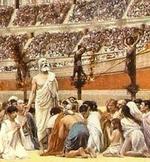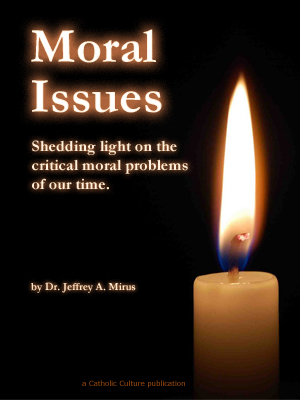Flashback: The Empty Square
By Phil Lawler ( bio - articles - email ) | Mar 27, 2025
Five years ago today, Pope Francis stood alone in a rainy St. Peter’s Square and gave his blessing—and the blessing of our Eucharistic Lord—to a world nearly paralyzed with fear of a contagious disease. That unique event furnished the most memorable visual image of this pontificate, and five years later many think of it as the moment that best reveals the nature of this Pope’s leadership. In a way, I agree.
Today Vatican News carries a comment by its editorial director, Andrea Tornielli, recalling that unforgettable scene in St. Peter’s. The title of the piece is ironically revealing: “An empty St. Peter’s Square and the pastor in tune with the world.” Again I agree; on that day Pope Francis showed that he was indeed in tune with the world. Unfortunately, the world was badly out of tune, panicked into grossly misplaced priorities.
What follows is the opening section of Chapter One in my book, Contagious Faith, written during the Covid lockdown on 2020, in which I tried to explain why the world had lost its sense of proportion, and (as the book’s subtitle puts it) “why the Church must spread hope, not fear, in a pandemic.”
Friday evening, March 27, 2020. The sun had already set in Rome at the end of a cold, blustery, raw, rainy day. St. Peter’s Square was dark, and all the more forbidding because it was empty—but for one man. Pope Francis walked alone across the windswept square, a bit hunched over, with his mild but noticeable limp. There were no acolytes beside him, no other prelates to assist him at the altar. Invoking God’s protection against the scourge of the coronavirus, he raised a monstrance containing the Blessed Sacrament, and with it gave his blessing Urbi et Orbi: to the city and the world.
“No director could have created such a powerful scene,” said the Italian screenwriter Massimiliano Perrotta—who has made it his life’s work to create powerful scenes. Here was a single man, a tiny figure in the vast square that can accommodate tens of thousands; an AP report described him as “utterly alone before an invisible enemy.” The darkness, the silence, the inclement weather all contributed to the ominous sense that this lone man, standing for all mankind, was facing an enormous and implacable foe.
But then there was one even more powerful factor, cutting through the gloom, promising to dispel the darkness: the Lord of the universe, present in the Eucharist, the source of all hope. No believing Catholic could doubt the effective power of the papal blessing. Pope Francis was wielding the infinite power of the Eucharist, the source and summit of our faith. The faithful could draw comfort and confidence in Christ’s protection.
Still, powerful as it was, there was something missing from this scene. The Pope was alone, but the Eucharist is meant to be shared. This was a religious ritual without a congregation. The Pope was blessing the people: the people of Rome and the people of the world.
But the people weren’t there.
Two days earlier, in a public audience on the feast of the Annunciation, the Pontiff had asked all the world’s faithful to join him in prayer on this day. But he had asked them to join him remotely, watching the ceremony on television or the internet. St. Peter’s Square had been closed to the public.
All through Rome—and soon, all around the world—Catholic churches had closed their doors. In a stunning development, without any precedent in the history of the Church, the faithful were prevented from attending the Mass, barred from the sacraments, not by secular persecutors but by the choice of their own bishops. Two weeks later, during Holy Week, as they faced the bleak prospect of an Easter without a Mass, devout Catholics could feel the sorrow of Mary Magdalen, weeping at the empty tomb: “Because they have taken away my Lord, and I do not know where they have laid Him.” (Jn 20:13)
AN INTERLUDE OR A TREND?
This is a book about a time when leaders of the Catholic Church told their people not to come to church. A time when Church leaders encouraged the public to think that the preservation of physical health should take precedence over the needs of spiritual growth. A time when some of the most zealous Catholics resisted their leaders’ message. A time when the Catholics who are ordinarily most docile to Church authority found themselves deliberating circumventing their bishops’ directives, in order to receive the sacraments.
Was that dramatic March 27 ceremony in St. Peter’s Square a harbinger of what was to come in the Catholic Church: with the Pope alone, with the people absent? Did this eerie interlude expose some serious differences between the hierarchy and the faithful, and/or between contrasting understandings of what the Church is and does? When pastors advise parishioners not to come to Sunday Mass, not to worry about Confession, not to marry and baptize, can they reasonably expect the people to return to the sacraments once (if ever) the crisis ends? What does the Catholic Church have to offer to the faithful, and to the world at large, in a time of crisis, in the face of worldwide fear? Has the Church been faithful to her mission, and fulfilled her role in the time of need? Or missed an opportunity to spread the Gospel, to bring hope to a world on the brink of despair? These are the questions that I explore in the pages that follow.
My opinions are my own. I claim no special authority. I have only the mandate that applies to every baptized Christian, to do my best to spread the faith, to read the signs of the times as best I can. My conclusions may be wrong. In fact I hope they are wrong, because their implications are distressing. If I am mistaken, I hope that better analysts and better Christians (of whom there are many) will provide better answers to my questions. But the questions must be asked, and they should be answered.
All comments are moderated. To lighten our editing burden, only current donors are allowed to Sound Off. If you are a current donor, log in to see the comment form; otherwise please support our work, and Sound Off!








